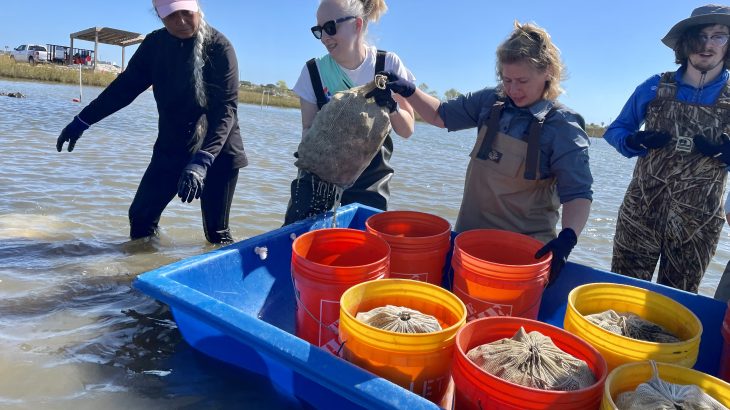It might sound strange, but oysters can be gardened! Oyster larvae are free swimming in the water and require a hard substrate to attach to in order to grow and survive. Once the larvae find a hard surface, which can be existing oyster shells, rocks, wood, or even the bottom of a boat, the larvae will cement itself to that surface. When this happens, the oyster larvae enter the juvenile stage of life and are then referred to as spat. As the spat begins to grow, it creates its own shell on the surface it settled itself onto. The spat will eventually develop into an adult oyster, which will remain on this hard surface for the remainder of its life.
Given the importance of finding a suitable hard surface to ensure a complete oyster lifecycle, the Galveston Bay Foundation’s (GBF) oyster gardening initiative has worked since 2012 to foster relationships in bayfront communities to “garden” oysters. Waterfront homeowners in communities within Galveston Bay volunteer as oyster gardeners and suspend mesh bags, stringers, or cages containing recycled oyster shells (“oyster gardens”) from their piers, docks, or bulkheads to recruit oyster larvae. The oyster gardens are submerged in the bay during the spawning season, approximately May through November. Volunteers monitor and care for the oyster gardens throughout the summer and early fall to promote successful growth of spat recruited on the recycled shell.
In the fall, GBF staff collect the oyster gardens from the volunteers and spread the shells and new oysters on nearby restoration reefs to enhance the local oyster population and continue their important water filtration work. Did you know that one oyster can filter 50 gallons of water per day?! Volunteers not only learn about the lifecycle of the Eastern oyster and the importance of oyster reefs in the Galveston Bay ecosystem, but they are also exposed to a variety of marine life, such as fish, shrimp, crabs, mussels, and barnacles, that find shelter in the oyster gardens. Furthermore, oyster gardening volunteers can participate in citizen science through GBF’s oyster recruitment studies.
If you have access to waterfront property located on Galveston Bay and are interested in participating, please consider becoming an oyster gardener with Galveston Bay Foundation! Sign up to become involved here or learn more via the Galveston Bay Foundation website.
